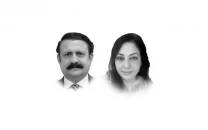A tale of two economic models
Famous Gujarat Economic Model introduced by Bharatiya Janata Party (BJP) and ‘Delhi’s Economic Model

As the Government of Pakistan is grappling with the economic meltdown and trying to stabilise the macroeconomic indicators, it is important to look at Pakistan’s eastern neighbour, India, and two economic models of two different political parties. The Indian politics is currently revolving around two economic models — the famous Gujarat Economic Model introduced by Bharatiya Janata Party (BJP) and ‘Delhi’s Economic Model, introduced by Aam Admi Party (AAP).
Gujarat’s economic model was introduced by the Narendra Modi, who served as the Chief Minister of Gujarat between 2001 and 2014. When Modi was sworn in as CM in 2001, Gujarat’s GDP was growing with meagre 1.1 per cent and unemployment was on the rise.
Furthermore, Gujarat was facing multiple challenges such as collapse of textile industry, loadshedding of electricity, communal riots and severe water short[1]ages due to drought. In 2001-2002, Gujarat experienced 60 per cent job losses due to contraction of small and medium industries.
However, in next 20 years Gujarat’s GDP witnessed an unprecedented growth of 2,349 per cent. Currently, Gujarat is India’s fourth largest industrial state and largest exporter of Indian goods i.e. 33 per cent of total Indian exports. To change Gujarat’s destiny, Modi’s Gujarat government primarily introduced four major initiatives — single window clearance system; land banking system; resolution of water shortage; and overcoming loadshedding.
With these governance reforms, Modi had been able to attract massive foreign and local investments in the state of Gujarat. In summary, Gujarat’s economic model is improving governance indicators, attracting foreign and national investments and empowering people through indus[1]trialisation and enhancement of exports.
Unlike Gujarat’s economic model, Delhi’s economic model is based on public welfare by solving socio-economic problems of the poor. Delhi’s welfare economic model is primarily a reaction to Modi’s Gujarat economic model.
Arvind Kejriwal, former bureaucrat turned politician, introduced this model with an aim of providing better and quality life to Delhi’s public. According to this economic model, quality education, health services at the doorsteps of every resident of Delhi, improvement of existing cities into smart cities, provision of security through CCTV surveillance, providing conducive environment for start-ups to young students and curbing corruption especially in government offices are some important elements of this economic model. It is because of these initiatives that Delhi’s government schools have been ranking at the top in all across India. This is mainly because Kejriwal has been allocating 25 per cent state’s budget to education. According to some estimates, 73 per cent residents of Delhi also get free of cost electricity. Public transport infrastructure has also witnessed unprecedented growth offering convenience to the citizens of Delhi. Free water and free Wifi have also been provided to the Delhi’s residents.
Despite all these extraordinary expenditure on public services, the Delhi government has shown surplus budget, which is mainly attributed to curbing the menace of corruption and significant reduction of government’s unproductive expenditures. Delhi’s government has doubled its revenue from INR 30,000 crores to 69,000 crores by increasing wellbeing of the people of Delhi. By offering extraordinary public services to the citizens, Delhi’s economic model is expecting improvement in socio-economic conditions of the residents of Delhi.
While both economic models in one way or the other are relevant to the resolution of current economic predicaments of Pakistan, the Gujarat model seems more attractive and sustainable for the federal government. The first two initiatives of Gujarat’s economic model can effectively resolve Pakistan’s current macro-economic problems.
Pakistan needs to set up similar kind of ‘single window clearance system’ for foreign and local investors with only 48 hours of clearance procedures, that too from one office. In this context, the government needs to develop an automated centrally connected online system. Further, a third party — preferably from private sector — needs to be hired to guide and facilitate investors in their clearance process.
Likewise, under the second phase of China-Pakistan Economic Corridor (CPEC), China and Pakistan planned to establish nine Special Economic Zones (SEZs). However, Pakistan is facing the land acquisition issue in majority of SEZs cases.
For not only facilitation of SEZs but also for other large-scale industries in future, the government needs to establish ‘land banking system’, where government has to acquire suitable land so that it could provide land to large-scale industries on a very short notice. By addressing these fundamental issues of governance, Pakistan can learn significantly from the economic models of Gujarat and Delhi.









1733130350-0/Untitled-design-(76)1733130350-0-208x130.webp)




COMMENTS
Comments are moderated and generally will be posted if they are on-topic and not abusive.
For more information, please see our Comments FAQ